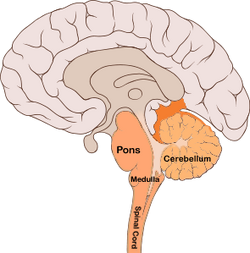No edit summary |
No edit summary |
||
| Line 1: | Line 1: | ||
{{BioPsy}} |
{{BioPsy}} |
||
| + | {{Infobox Brain| |
||
| ⚫ | |||
| + | Name = {{PAGENAME}} | |
||
| + | Latin = tractus corticonuclearis | |
||
| + | GraySubject = | |
||
| + | GrayPage = | |
||
| + | Image = Brain bulbar region.PNG | |
||
| + | Caption = Components and location of the corticobulbar tract. | |
||
| + | Image2 = | |
||
| + | Caption2 = | |
||
| + | IsPartOf = | |
||
| + | Components = | |
||
| + | Artery = | |
||
| + | Vein = | |
||
| + | BrainInfoType = ancil | |
||
| + | BrainInfoNumber = 371 | |
||
| + | MeshName = | |
||
| + | MeshNumber = | |
||
| + | DorlandsPre = t_15 | |
||
| + | DorlandsSuf = 12816062 | |
||
| + | }} |
||
| ⚫ | |||
| ⚫ | |||
| − | |||
| ⚫ | |||
The muscles of the face, head and neck are controlled by the corticobulbar system, which terminates on [[motor neuron]]s within brainstem motor [[cranial nerve nuclei|nuclei]]. This is in contrast to the [[corticospinal tract]], which connects the cerebral cortex to spinal motor neurons, and controls movement of the torso, upper and lower limbs. |
The muscles of the face, head and neck are controlled by the corticobulbar system, which terminates on [[motor neuron]]s within brainstem motor [[cranial nerve nuclei|nuclei]]. This is in contrast to the [[corticospinal tract]], which connects the cerebral cortex to spinal motor neurons, and controls movement of the torso, upper and lower limbs. |
||
| + | |||
| + | The corticobulbar tract innervates cranial motor nuclei bilaterally with the exception of the lower facial nucleus which is innervated contralaterally. Among those nuclei that are bilaterally innervated a slightly stronger connection contralaterally than ipisilaterally is observed. |
||
==External links== |
==External links== |
||
| − | * {{ |
+ | * {{BrainstemWisconsin|07CNXII}} |
| + | * http://thebrain.mcgill.ca/flash/i/i_06/i_06_cl/i_06_cl_mou/i_06_cl_mou.html |
||
| + | {{Mesencephalon}} |
||
[[Category:Central nervous system pathways]] |
[[Category:Central nervous system pathways]] |
||
| + | {{enWP|Corticobulbar tract}} |
||
| − | [[Category:Cerebral cortex]] |
||
| − | [[Category:Brainstem]] |
||
| − | [[Category:Posture]] |
||
Revision as of 21:58, 1 June 2007
Assessment |
Biopsychology |
Comparative |
Cognitive |
Developmental |
Language |
Individual differences |
Personality |
Philosophy |
Social |
Methods |
Statistics |
Clinical |
Educational |
Industrial |
Professional items |
World psychology |
Biological: Behavioural genetics · Evolutionary psychology · Neuroanatomy · Neurochemistry · Neuroendocrinology · Neuroscience · Psychoneuroimmunology · Physiological Psychology · Psychopharmacology (Index, Outline)
| Brain: Corticobulbar tract | ||
|---|---|---|
| Components and location of the corticobulbar tract. | ||
| [[Image:|250px|center|]] | ||
| Latin | tractus corticonuclearis | |
| Gray's | subject # | |
| Part of | ||
| Components | ||
| Artery | ||
| Vein | ||
| BrainInfo/UW | ancil-371 | |
| MeSH | [1] | |
The corticobulbar (or corticonuclear) tract is a white matter pathway connecting the cerebral cortex to the brainstem (the term "bulbar" referring to the brainstem).
The 'bulb' is an archaic term for the medulla oblongata. In clinical usage, it includes the pons as well.
The muscles of the face, head and neck are controlled by the corticobulbar system, which terminates on motor neurons within brainstem motor nuclei. This is in contrast to the corticospinal tract, which connects the cerebral cortex to spinal motor neurons, and controls movement of the torso, upper and lower limbs.
The corticobulbar tract innervates cranial motor nuclei bilaterally with the exception of the lower facial nucleus which is innervated contralaterally. Among those nuclei that are bilaterally innervated a slightly stronger connection contralaterally than ipisilaterally is observed.
External links
- Brainstem at UWisc 07CNXII
- http://thebrain.mcgill.ca/flash/i/i_06/i_06_cl/i_06_cl_mou/i_06_cl_mou.html
| This page uses Creative Commons Licensed content from Wikipedia (view authors). |
